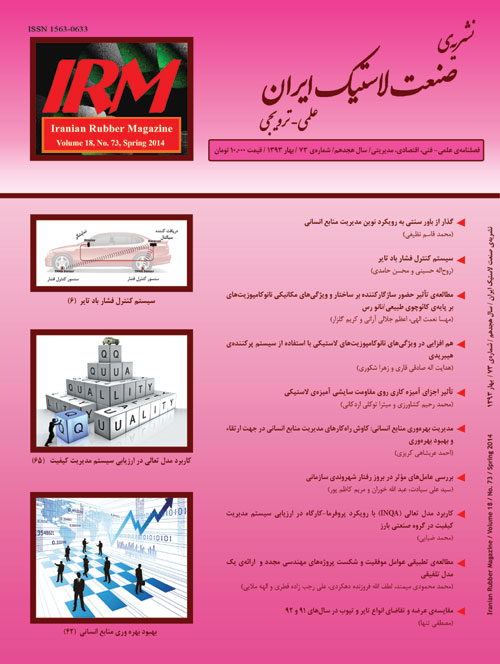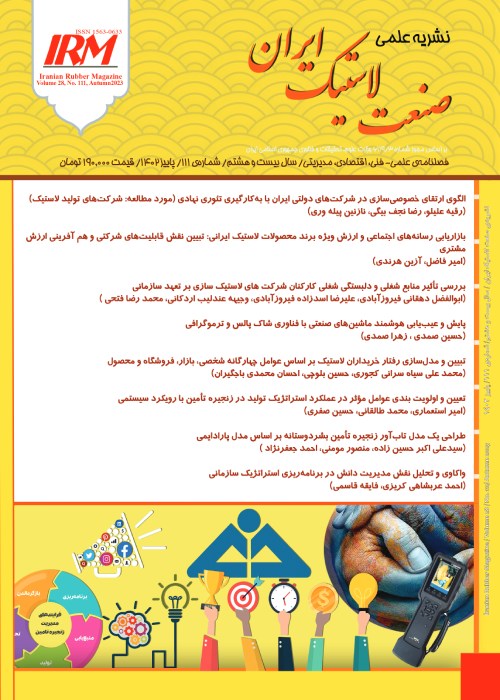فهرست مطالب

نشریه صنعت لاستیک ایران
پیاپی 73 (بهار 1393)
- تاریخ انتشار: 1393/03/19
- تعداد عناوین: 10
-
- سرمقاله
- علمی فنی
-
صفحه 6
- بهره وری
- مدیریت
- ازریابی عملکرد
- گزارش
-
Page 6Tire pressure monitoring system is the means by which the driver can be aware of the air pressure and temperature of the tires. Too low or too high air pressure inside the tires of a car and too high temperature, have many risks for the car driver and its passengers. The system acts by aid of sensors embedded inside the tire and sending the information via radio signals to a central control unit and if necessary, using audio and visual warnings, can aware the driver of the potential risks. In this paper, a variety of tire pressure monitoring systems and their importance, are discussed.Keywords: Tire pressure monitoring, Pressure sensor, Energy harvesters, Battery
-
Page 11Addition of nano materials such as nano clay to natural rubber could be one of the ways to improve its properties. The properties of natural rubber/clay nanocomposites depend on the silicate layers dispersion and the formed intercalated/exfoliated structure in nanocomposite. Compatiblizers can be used to increase the interaction between hydrophilic silicate layers and hydrophobic rubbery chains. In this paper the effects of some compatiblizers such as maleic anhydride grafted rubbers, epoxidized natural rubber and poly ethylene glycol, on properties of natural rubber/organoclay based nanocomposites were studied and compared. This study showed that the compatibility between natural rubber and compatiblizer, the polarity and the amount of compatiblizer, the variation of vulcanization and rheological behavior of nanocomposite in presence of compatiblizer affects the compatiblizer efficiency.Keywords: Natural rubber, Nanocomposite, Nano layered silicate, Compatibilizer
-
Page 21Improving the performance of polymer products has always been considered by the researchers and manufacturers. By introducing nanotechnology to the polymer science, improving the properties and performance of polymer products such as plastics, rubbers and other types of polymeric products was intensified. In this regard, the use of nanoparticles for enhancing the mechanical performance of the rubbers has received more attention. But despite of many researches in the field of single filled polymer nanocomposites in the recent years, hybrid nanocomposites consists of several fillers are being investigated and not yet useable in the process. In this paper examines the performance of hybrid filler systems consist of nanoclay, carbon black, calcium carbonate, silica, carbon nanotube in rubber nanocomposites like NR, ENR, SBR, PU, BIIR, EPDM and NBR are discussed and a comparison between single-filler and hybrid filler nanocomposites was carried out. In this regard, greater focus on the morphology and mechanical properties and dynamic - mechanical properties of rubber nanocomposites were studied. For this purpose, the research conducted in the field of rubber nanocomposites in recent years which published by several researchers, their results are presented along with the scientific analysis and the favorable effect of these hybrid fillers on the performance of rubber products clearly displayed.Keywords: Nanocomposite, Nanoclay, Hybrid filler system, Morphology, Mechanical properties
-
Page 33The properties of a vulcanized rubber can be significantly influenced by details of the compounding. Practical materials will have, in addition to the base polymer, fillers, antidegradants, crosslinking agents, accelerators etc. In this paper, the influence of these factors on the abrasion compounds have been studied.Keywords: Abrasion Resistance, Rubber
-
Page 42Developed and developing countries have made important efforts for productivity improvement. And one of the factors affecting growth and development in these countries is the productivity factor. However, in our country, there is not enough attention to the productivity factor. Most organizations and companies do not care for productivity. While the root of many problems in different parts of the country, is the lack of efficiency and productivity. So, to achieve development, we should take effective steps in this field. Human resources in organizations is the most important production factor, And one of the main areas for productivity improvement is human resource management. First, we discuss the nature and concept of human resource management and productivity. Then we review the research literature. Finally, we examine the science of human resource management and offer solutions for improving productivity.Keywords: Efficiency, Profitability, Effectiveness, Productivity, Human resource management
-
Page 53So far, much research has been done on organizational behavior citizenship (OCB), and either way the variables studied, but so far, no comprehensive study on the barriers and its grounds has been. Therefore, the present study addition addressing the concept of organizational behavior sitizenship and it’s importance and necessity in organizations, studied The barriers on OCB and Finally, The most important factors affecting the OCB has been discussed. Finally, results showed that the factors affecting OCB: Organizational commitment, job satisfaction, transformational leadership, organizational justice, organizational support, personality, morality, the prevailing political climate, attitudes and demographic variables. Absoletely, with the knowledge and understanding of the factors and issues, organizations managers will be able to see a broader, more comprehensive and more informed look into the issue of OCB and can earn interest in order to enhance the performance of your employees.Keywords: Organizational behavior citizenship, Extra, role behaviors, Competitive advantage
-
Page 65Several studies have identified the key success factors to improve the performance of organizations and National Quality Awards for Business Excellency so as Deming Prize, the Malcolm Baldrige and EFQM Make it. Models have been developed in other countries, as well as a combination of the above models inspired. Iran National Quality Award (INQA) One of them. INQA presents assessment criteria information system for organization to evaluate organization performance and excellence in quality. The purpose of this study was to implement INQA model through information system Performa-Workshop system Barez Industrial Group. This was an applied and descriptive cross-sectional research. Data collection instrument was an approach information performa-workshop system. Collected data were analyzed through descriptive statistics using SPSS and INQA softwares. Score for each of seven factors and 25 subfactors according to RADAR logic was calculated Performa Information System approach in this model provided a system of information about strength area that needs improvement in Quality Management System in Barez Industrial Group by using RADAR logic for improvement case and change were followed.Keywords: Excellence model, Quality, Assessment, Management, RADAR, Excellency
-
AComparative Study of Success and Failure in Re-engineering Projects and Provide an Integrated ModelPage 77Reengineering is the fundamental approach for rethinking and redesigning of process in order to obtain dramatic improvements in performance of organization, reducing time, cost, and human resources. This concept is provided by Hammer and Davenport and Short in 1990. Many organizations have reported dramatic benefits gained from the successful implementation of re-engineering projects but Hammer and Champy noted that as many as 70 percent do not achieve the dramatic results they seek in 1993. This paper examines success and failure of re-engineering projects and provides a model of Integrated the Re-engineering. The factors of model are: "top management commitment and support", "change management", "strategic alignment", "Understand the principles and concepts of re-engineering", "project management", "Reengineering Team", "methodology", "IT infrastructure", "Implementation", "Empowering Employee" and "adequate financial resources". Each of attention or neglect to these factors can lead to the success or failure of reengineering projects.Keywords: Reengineering, Success, failure factors, Integrated model


